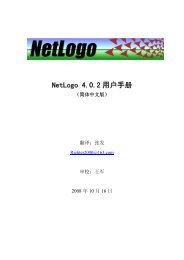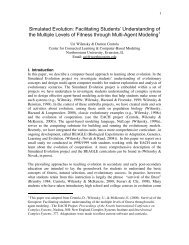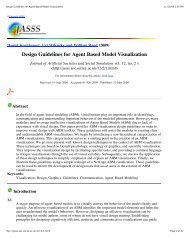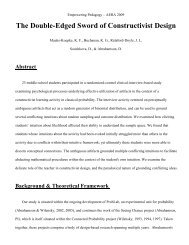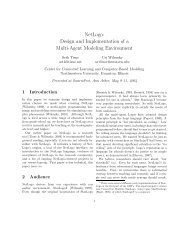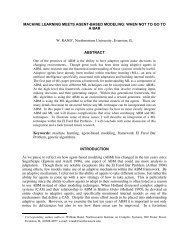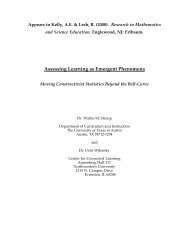Finding Forms of Flocking - The Center for Connected Learning and ...
Finding Forms of Flocking - The Center for Connected Learning and ...
Finding Forms of Flocking - The Center for Connected Learning and ...
You also want an ePaper? Increase the reach of your titles
YUMPU automatically turns print PDFs into web optimized ePapers that Google loves.
<strong>The</strong> objective functions were different <strong>for</strong> each task, <strong>and</strong> will be discussed<br />
individually in each <strong>of</strong> the investigations below (Sections 4.1-4.4). For efficiency,<br />
objective function values were cached after being computed. 2 <strong>The</strong> search algorithms<br />
were stopped after they had run the ABM 12000 times. Each search was<br />
repeated 30 times (except <strong>for</strong> the volatility exploration in Section 4.3, which<br />
was repeated 60 times <strong>for</strong> improved statistical confidence), to evaluate search<br />
per<strong>for</strong>mance <strong>and</strong> ensure that search findings were not anomalous.<br />
3.3 BehaviorSearch<br />
To per<strong>for</strong>m these searches, we developed a new tool called BehaviorSearch [16],<br />
which was implemented in Java, <strong>and</strong> interfaces with the NetLogo modeling environment,<br />
using NetLogo’s Controlling API. BehaviorSearch is an open-source<br />
cross-plat<strong>for</strong>m tool that <strong>of</strong>fers several search algorithms <strong>and</strong> search-space representations/encodings,<br />
<strong>and</strong> can be used to explore the parameter space <strong>of</strong> any<br />
ABM written in the NetLogo language. <strong>The</strong> user specifies the model file, the desired<br />
parameters <strong>and</strong> ranges to explore, the search objective function, the search<br />
method to be used, <strong>and</strong> the search space encoding, <strong>and</strong> then BehaviorSearch<br />
runs the search <strong>and</strong> returns the best results discovered, <strong>and</strong> optionally the data<br />
collected from all <strong>of</strong> the simulations run along the way. BehaviorSearch supports<br />
model exploration through both a GUI (see Figure 1), <strong>and</strong> a comm<strong>and</strong> line interface.<br />
A beta-release <strong>of</strong> BehaviorSearch is freely available <strong>for</strong> download 3 . <strong>The</strong><br />
s<strong>of</strong>tware design purposefully resembles that <strong>of</strong> the widely-used BehaviorSpace<br />
[19] parameter-sweeping tool that is included with NetLogo. Our intent is to<br />
make advanced search techniques accessible to a wide range <strong>of</strong> modelers so that<br />
the methods <strong>and</strong> ideas discussed in this paper can be put into practice.<br />
4 Explorations<br />
4.1 Investigation 1: Convergence<br />
<strong>The</strong> convergence <strong>of</strong> swarm-based systems is one potential property <strong>of</strong> interest,<br />
<strong>and</strong> has been <strong>for</strong>mally studied <strong>for</strong> some theoretical cases [5]. Thus, the first behavior<br />
<strong>of</strong> interest <strong>for</strong> the <strong>Flocking</strong> model was the ability <strong>of</strong> birds starting at<br />
r<strong>and</strong>om locations <strong>and</strong> headings to converge to be moving in the same direction<br />
(i.e. directional, not positional, convergence). In order to make the search process<br />
effective, we must provide a quantitative measure to capture the rather qualitative<br />
notion <strong>of</strong> convergence. This quantitative measure (the objective function)<br />
will provide the search with in<strong>for</strong>mation about how good one set <strong>of</strong> parameters<br />
is, relative to another, at achieving the goal. Specifically, we would like to find<br />
2 <strong>The</strong> goal <strong>of</strong> caching is to avoid repeating expensive computations. However, because<br />
the model is stochastic, re-evaluating points in the search space could lead to different<br />
results than the cached values, meaning that the search process is affected by caching.<br />
For further discussion <strong>of</strong> noise/uncertainty <strong>and</strong> fitness caching, see [17].<br />
3 Available at: http://www.behaviorsearch.org/





